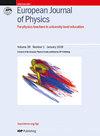Pressure Gradient in an Incompressible Fluid as a Reaction Force and the Preservation of the Principle of `Cause and Effect`
IF 0.8
4区 教育学
Q4 EDUCATION, SCIENTIFIC DISCIPLINES
引用次数: 0
Abstract
Abstract When considering the motion of an incompressible fluid, it is common practice to take the curl on both sides of the Navier–Stokes (or Euler) equations and cancel the pressure force. The governing equations are sufficient to derive the velocity field of the fluid without any knowledge of the pressure. In fact, the pressure is only calculated after obtaining the velocity field. This raises a number of conceptual problems. For instance, why is the pressure unnecessary for obtaining the velocity field? Traditionally, forces have been considered as the ‘causes’ of motion, and the resulting acceleration as the ‘effect’. However, the acceleration (the effect) and the resulting velocity field can be obtained without any recourse to the pressure (the cause), seemingly violating the principle of ‘cause’ and ‘effect’. We address these questions by deriving the pressure force of an incompressible fluid, starting from d’Alembert’s principle of virtual work, as a ‘reaction force’ that maintains the incompressibility condition. Next, we show that taking the curl on both sides of the Navier–Stokes (or Euler) equations is equivalent to using d’Alembert’s principle of virtual work, which cancels out the virtual work of the pressure gradient. This shows that abstract procedures, such as taking the curl on both sides of an equation, can actually be tacit applications of rich physical principles, without one realizing it. This can be quite instructive in a classroom of undergraduate students.不可压缩流体中的压力梯度作为反作用力与“因果”原理的保持
当考虑不可压缩流体的运动时,通常的做法是取Navier-Stokes(或Euler)方程两侧的旋度并消去压力。控制方程足以在不知道压力的情况下推导流体的速度场。实际上,压力是在得到速度场后才计算出来的。这就提出了一些概念上的问题。例如,为什么不需要压强来求速度场?传统上,力被认为是运动的“因”,而产生的加速度被认为是“果”。然而,加速度(结果)和由此产生的速度场可以不依赖于压力(原因)而获得,这似乎违反了“因”和“果”的原则。我们通过推导不可压缩流体的压力来解决这些问题,从达朗贝尔虚功原理开始,作为维持不可压缩条件的“反作用力”。接下来,我们证明在纳维-斯托克斯(或欧拉)方程两侧取旋度相当于使用达朗贝尔虚功原理,它抵消了压力梯度的虚功。这表明,抽象的过程,比如取方程两边的旋度,实际上可以是丰富的物理原理的隐性应用,而没有人意识到它。这对一群本科生来说很有教育意义。
本文章由计算机程序翻译,如有差异,请以英文原文为准。
求助全文
约1分钟内获得全文
求助全文
来源期刊

European Journal of Physics
物理-物理:综合
CiteScore
1.70
自引率
28.60%
发文量
128
审稿时长
3-8 weeks
期刊介绍:
European Journal of Physics is a journal of the European Physical Society and its primary mission is to assist in maintaining and improving the standard of taught physics in universities and other institutes of higher education.
Authors submitting articles must indicate the usefulness of their material to physics education and make clear the level of readership (undergraduate or graduate) for which the article is intended. Submissions that omit this information or which, in the publisher''s opinion, do not contribute to the above mission will not be considered for publication.
To this end, we welcome articles that provide original insights and aim to enhance learning in one or more areas of physics. They should normally include at least one of the following:
Explanations of how contemporary research can inform the understanding of physics at university level: for example, a survey of a research field at a level accessible to students, explaining how it illustrates some general principles.
Original insights into the derivation of results. These should be of some general interest, consisting of more than corrections to textbooks.
Descriptions of novel laboratory exercises illustrating new techniques of general interest. Those based on relatively inexpensive equipment are especially welcome.
Articles of a scholarly or reflective nature that are aimed to be of interest to, and at a level appropriate for, physics students or recent graduates.
Descriptions of successful and original student projects, experimental, theoretical or computational.
Discussions of the history, philosophy and epistemology of physics, at a level accessible to physics students and teachers.
Reports of new developments in physics curricula and the techniques for teaching physics.
Physics Education Research reports: articles that provide original experimental and/or theoretical research contributions that directly relate to the teaching and learning of university-level physics.
 求助内容:
求助内容: 应助结果提醒方式:
应助结果提醒方式:


